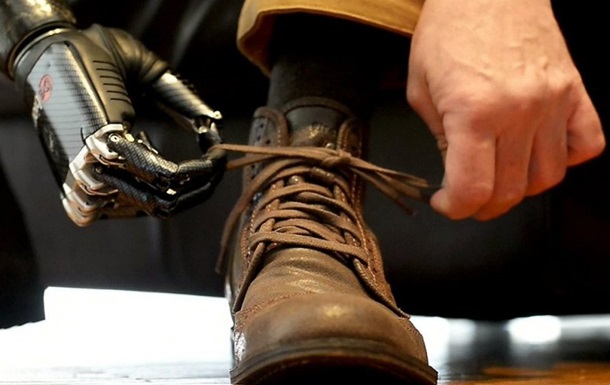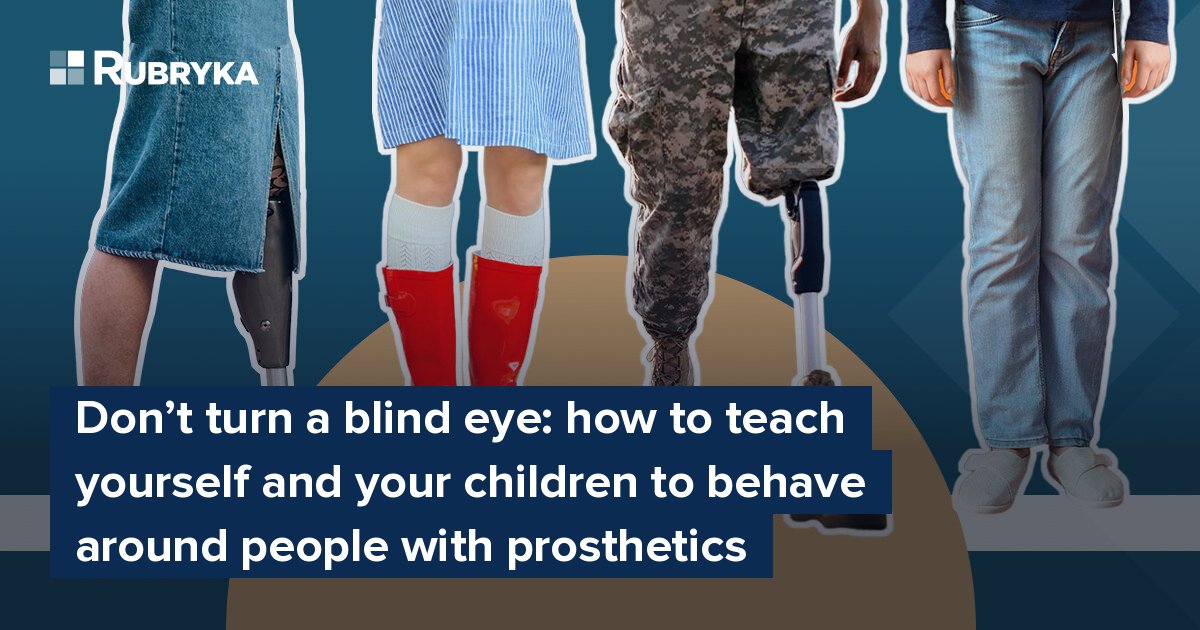
What is the problem?
The war in Ukraine has left many people seriously injured, and many more with prosthetics or mutilated body parts can be seen on the streets of relatively peaceful cities. Often, society does not know how to properly react to the wounded, so they simply look the other way.
Such a psychological reaction is determined by many factors, such as a sense of one's own vulnerability, socio-cultural prerequisites, and upbringing. However, it's possible to cope with these emotions and learn to be tolerant of all types of human bodies, and Rubryka will take you through the process.
What is the solution?
Understand what people with acquired disabilities feel

Photo: Ukrinform
People with amputations often imagine how others look at their new bodies. It can be difficult to cope with these thoughts. For example, research shows that losing an eye is more difficult for most people than losing vision. That is, the loss of function is not perceived as painfully as a change in appearance, as experts at the rehabilitation center Superhumans explains.
Military servicemember Oleksandr Teren, who lost his leg in the war and has already been equipped with a prosthetic, shares in one of his Instagram posts that people often feel embarrassed when they notice his prosthetic and this feeling transfers to him. The soldier wrote that just recently, walking along a completely crowded street toward the Kyiv hospital, fearing slipping on the March ice, he realized that many people were paying attention to him. He was, as usual, wearing shorts, as practicality prevailed over aesthetics in his choice of clothing. Involuntarily, the soldier looked down so as not to meet the embarrassed eyes of passers-by. He understood that he was also becoming embarrassed. "I don't want to be the cause of people's discomfort, the cause of averted eyes, or the cause of whispering. It wasn't my choice to be like this now and to differ in some way visually from an ordinary person. It was not me or thousands of others who wanted to feel such a difference with you," he writes.
Five behavioral taboos
If we know the dos and don'ts, it becomes easier to know how to act. Veterans and patients at the National Rehabilitation Center shared behavioral taboos about what not to do when seeing people with prosthetics.
It is important to know and be able to communicate with people who have experienced trauma. Veterans and patients of the NEZLAMNI center created a short guideline with seven basic rules of behavior when you meet a person with facial defects or a prosthetic.
🔸Don't stare. You should not look closely at a person with a facial defect or prosthetic. Even when you feel sorry for them and are very grateful. It makes them feel awkward and uncomfortable;
🔸 Don't say, "Get well!". If you are meeting a person with a prosthetic in a public place, it likely means they have already recovered. Their lost limb, unfortunately, will not grow back even if you wish it from the bottom of your heart;
🔸 Do not ask. Patients recall cases when people tried to start a conversation with them to try to be supportive. Sometimes people ask about how they got their wound or injury, or the details of rehabilitation. Not everyone is comfortable talking about this experience, so first, you should ask if the person is comfortable talking about their experience.
🔸Do not show pity. It is normal to feel sorry for someone and sympathize or empathize with a traumatized person, especially our defenders. However, these feelings should be expressed constructively, for example, by showing support or positive words about how well the person is doing.
🔸 Do not avoid. Many people are embarrassed or uncomfortable when they meet someone with a facial defect or a prosthetic. People do not know how to behave and do not know what to talk about. Injured people are full-fledged members of our society, often with special merits. They must not be avoided.
🔸Talk to your children as early as possible. Children often say exactly what comes to mind without a filter. Explain to them what a prosthetic is, and where it came from. This will help you avoid awkward situations when you meet someone with facial deformities or a prosthetic.
🔸Consent. You can continue the conversation, encourage, sympathize, or help only after receiving consent. It might also be better to stay silent.
The main rule for communication
Human relationships and reactions are always individual, and it's impossible to develop an exhaustive list of situations and recommendations for all occasions.
People who have returned from a war zone and re-entered a peaceful environment may behave differently. They may react more intensely to attempts to talk, especially with someone with no combat experience and no idea what is happening at the front.

One of the defenders who had a prosthetic installed. Photo: Yuriy Velychko
However, there is one universal rule: any action or intention should be asked first. And only after receiving consent can you continue the conversation, encourage, sympathize, or help. Remember that your help should not be intrusive, as this can offend and depress the person.
Another tip: be sincere. People can feel insincerity in words or looks, and the same goes for honesty.
"If you want to ask — ask; if you want to thank — thank! But know that this steel was obtained at the price of future victory, writes Teren.
How to explain this to children?
Children can often react to something new emotionally and loudly – attracting attention and putting parents in an uncomfortable position. For a child to learn tolerance, talk to them in advance.
Explain what a prosthetic is and where it came from. Talk about the fact that staring can be unpleasant for a person, and try to explain what they shouldn't do. In general, it is better to have such a conversation not only about people with lost or mutilated limbs, but about all human bodies.

A soldier learns to use his new hand.
Explain that people may have different weights and different skin colors. Some use wheelchairs, and may have visual, hearing, or mental disabilities — but this does not make them worse or better than other people.
Children need to understand that what may seem like a struggle — overcoming daily obstacles like opening a door — can actually be part of the normal process for someone with a disability. There is no need to do everything for someone with a disability. You can offer your help if it's really needed — or wait for a request for it. Being refused doesn't mean you should be offended. The fact that a person has a disability does not mean they need to be looked after — they will ask for help if they need it.
Let's not forget about communication — remind the children of the correct terms for defining a person's condition: words like "sick," "crippled," and "disabled" carry a stigma with them and should be considered taboo. The correct way is simple: "a person – with a disability."
What can help society?
Developing the proper behavioral patterns can be a long process that requires training and reminding people that everyone is different.
Teren, the servicemember with a prosthetic, decided to be part of changing the situation by showing his own example:
"It dawns on me that now I have to walk only in shorts — overcome my awkwardness and take away the awkwardness of society. The more people will see me and other people with prosthetics, the faster the transformation into a new people will happen, which has not only a will of steel, but steel legs, arms, and backs!" the soldier writes.
He reminds that if you see someone with prosthetics wearing shorts, know they might be embarrassed, too. Still, it is essential to overcome this awkwardness, accept reality as it is, and realize that we are all different – but can be equally strong and indomitable.







